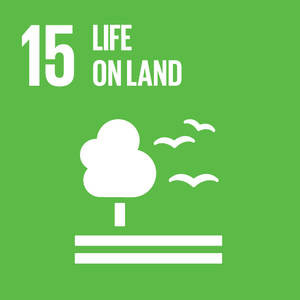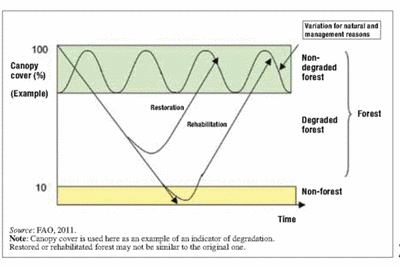Forest degradation is a global challenge, and it should be addressed at all levels (local, subnational, national and international). It is often the consequence of unsustainable forest management, the excessive exploitation of forest resources, and factors outside the specific forest area being managed. Forest degradation may be considered as a signal to alert us that sustainable forest management (SFM) is not being achieved.
It is difficult to implement SFM when the enabling conditions for SFM – that is, conducive policies, governance regimes, institutions, incentives, regulations, tenure, rights, transparency and stakeholder engagement – are absent. Forest and land managers can advocate for an enabling environment for SFM, and they can be key actors in halting and reversing forest degradation through their local-level actions.
The most important thing that forest managers can do is to adhere to the principles of SFM in their management approach, with the aim of ensuring that today’s uses and practices maintain and enhance the economic, social and environmental values of forests in perpetuity while also providing appropriate livelihoods. More specifically, forest managers should define and apply sound management plans, define and respect harvesting limits, monitor and detect signs of forest degradation and environmental impacts, and take appropriate and timely measures to halt or reverse degradation – including by requesting assistance and technical support when needed.
In forests under SFM, forest managers should regularly monitor the effects of management practices and assess whether they are causing degradation (see the Forest Management Monitoring module). SFM is a dynamic process, and forest management plans and practices should be adapted over time in light of monitoring and assessment and evolving economic, social and environmental conditions (see the Climate Change Adaptation and Mitigation module).
Forest degradation is best addressed by a comprehensive approach aimed at its direct and underlying drivers. The table provides examples of technical actions that can help prevent or halt forest degradation.
Examples of undesirable effects leading to forest degradation | Examples of actions to arrest forest degradation |
Reduction in site productivity | - Modify sustainable annual harvest |
Limited regeneration after logging | - Put in place practices to help forests recover after harvesting (e.g. assisted natural regeneration, enrichment planting) - Avoid reducing the population of any tree species to the extent that self-replacement is not possible (e.g. maintain a sufficient number of seed trees) - Modify logging practices to avoid future degradation |
Soil erosion | - Reduced impact logging - Mulching to improve soil conditions - Measures to maintain and improve the growth of groundcover vegetation |
Impact on wildlife populations | - Measures to reduce the impact of logging activities on local fauna (e.g. respecting reproductive periods) - Maintenance of connectivity across forest landscapes - Appropriate land-use planning |
Presence of pests | - Ensure that good practices are applied correctly (e.g. control entry pathways – see the Forest Pests module) |
Forest encroachment for agriculture/livestock | The following actions may be beyond the scope of forest managers and require the involvement of other land managers and actors: - Land-use planning - Promotion of sustainable practices - Promotion of alternative livelihoods - Law enforcement, awareness-raising and capacity building |
The Silviculture in Natural Forests module provides additional information.
When forest degradation is the result of natural causes such as storms, droughts, pests or wildfires, forest managers should aim to strengthen forest resilience so that stands are better prepared for future events. This can be done, for example, by maintaining biodiversity at varying forest scales (e.g. stand, landscape and region); applying integrated fire management (mainly risk reduction and recovery); applying integrated pest management; and (in planted forests) selecting tree species and varieties likely to be resilient in the face of expected future conditions (see also the Forestry Responses to Natural and Human-conflict Disasters module).
Forest and land managers can reverse degradation by restoring and rehabilitating forest landscapes (see Forest Restoration and Rehabilitation module) and through appropriate land-use planning.
In order to do so in a way that is efficient for the community and the environment, both men and women forest managers must take gender considerations into account. Overall, the degradation of forests affects men and women differently. In rural areas, a woman’s life is fundamentally dependent on nature, since she has to maintain her family by managing and using natural resources (e.g. women are primary providers of household food, fuel and water for cooking, heating, drinking and washing). Climate and biodiversity alterations caused by forest degradation largely hinder women’s livelihoods.
When assessing forest conditions and planning a reverse degradation project, forest managers must consider women’s needs, as well as the role they play as mitigating agents. If trained and empowered, women can lead the fight against degradation. They have a very close relationship with forests and trees and can recognize the undesirable effects of forest degradation such as soil depletion, reduced productivity and regeneration, and the presence of pests. This knowledge can be applied to adopt mitigation measures. For instance, composting kitchen waste may provide soil-enriching fertilizer. Since women know the life cycles of the trees and plants, they are inestimable resources for land use planning, especially when it comes to sustainable harvests, seed conservation and maintenance.





